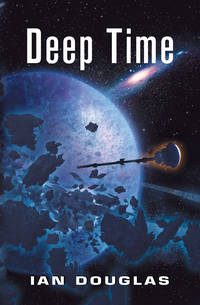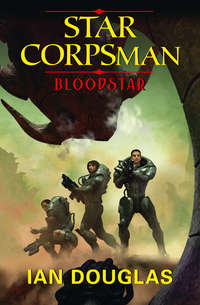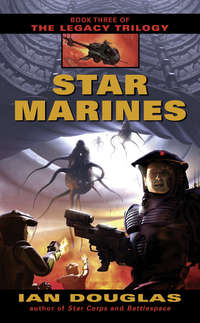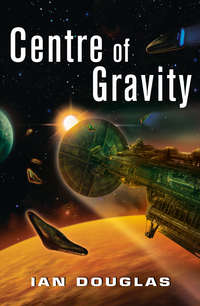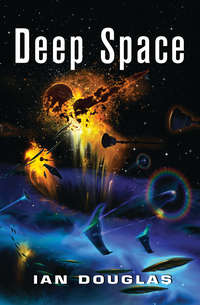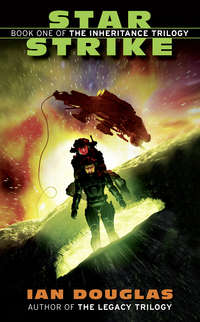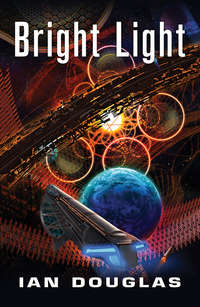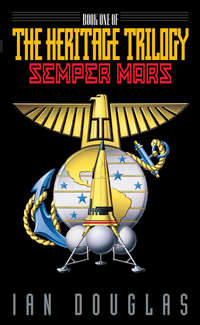
Полная версия
Singularity
Texaghu Resch was a G2-type star almost identical to Sol … but it simply hadn’t won the planetological crapshoot that would have led to its possessing a planet humans could call home.
Something was flashing red in the tactical tank. Koenig looked … then blinked. There was something there. America’s instrumentation was picking up a gravitational anomaly. In essence, the ship was feeling about twice the force of gravity it should be feeling at this distance from a G-class star. It was exactly as though there were two stars in there—a close binary—each of about one solar mass … but one of the stars was invisible.
Either that, or the single visible star was twice as massive as it should be, and that simply wasn’t possible, not within the rules governing stellar classification as humans now understood them.
“Admiral?” another voice said. “This is Lieutenant Del Rey, in Astrogation.”
“Go ahead.”
“Have you seen the GA alert, sir?”
“Yes, I have. What do you make of it?”
“We didn’t know what the hell it was at first. We still don’t. But … take a look at this, sir.”
A visual feed came through, opening as a new window within Koenig’s in-head display. It appeared to be a highly magnified image of a portion of the star itself, with the light drastically stepped down by the AI controlling it. Koenig could see the curving limb of the star, the mottling of the surface granulation, the sweep and arch of stellar prominences. At first, he saw nothing out of the ordinary.
And then …
“Good God!” he said, expanding the image for a closer look. “What the hell is that?”
“We have no idea, sir,” Del Rey replied. “But we thought it might be important.”
And that, Koenig thought, was a hell of an understatement.
Chapter Six
29 June 2405
VFA-44
Outer System, Texaghu Resch System
112 light years from Earth
1106 hours, TFT
“PriFly, this is Dragon One,” Gray called. “What’s the hang-up?” They were supposed to have dropped two minutes before, but Primary Flight Control had called for a hold.
“Wait one, Dragon One,” a voice replied—one of the traffic control personnel in PriFly. “There’s been a hitch. The Space Boss is talking to the admiral now.”
The “Space Boss” was Commander Avery, America’s primary flight controller.
Gray scowled. His cockpit was projecting a view of surrounding space, overlaid with icons representing the ships of CBG-18 as they continued to emerge from metaspace. A dozen Confederation vessels were out there, now, with more popping in every moment as the light from their Emergence reached the America’s sensors.
There were no icons representing enemy or unknown vessels. It appeared that this system might be clean.
Possibly the drop was going to be scrubbed.
Well, that was the battle cry of the Navy: hurry up and wait.
“Dragonfire Squadron, this is PriFly,” Commander Avery said. “The drop is scrubbed. Repeat, the drop is scrubbed. VFA-51 will remain on Ready Five. All others will stand down.”
VFA-51, the Black Lightnings, was one of the Dragonfires’ sister Starhawk squadrons on board the America. Commander Alton Crane was their new skipper, and like the Dragonfires, they’d taken heavy losses at Alphekka, and a good half of the pilots were newbies.
Gray felt a jolt as his Starhawk began rising within its magnetic cradle. A moment later, it passed through the drop-tube vacuum seal, allotropic composites within a nanomatrix that made solid metal flow like a thick, viscous liquid, allowing the fighter to be drawn into the carrier’s flight deck while maintaining the compartment’s atmospheric pressure. His cockpit melted open and swung away as a rating outside triggered steps that grew out of the deck.
“Short flight, huh?” the guy said, grinning.
“The best kind,” Gray replied with considerable feeling. “Uneventful.”
An hour later, Gray entered the crew’s lounge, located at the third-G level of America’s number-two hab-module stack. The compartment was large and furnished more like a civilian social center Earthside, with numerous entertainment pits, food bars, and low couches grown from the deck and turned soft. The overhead was an enormous dome, and at the moment, it was displaying the view outside. The local star, yellow, bright, and showing a tiny disk, gleamed halfway up the gently curving bulkhead.
Shay Ryan spotted him and walked over. “Hey, Skipper,” she called. “Looks like they don’t want us here, either.”
Like Gray, Ryan was a Prim, formerly of the Periphery areas that once had been Washington, D.C., until rising sea levels had reclaimed the lowland areas as a ruin-littered salt marsh. Like Gray, she’d joined the service because she’d had few decent options. Like him, she mistrusted both government authority and technology, but she’d tested well on her inborn spatial and coordination skills, and they’d made her a fighter pilot.
“Hello, Shay,” he said. He walked over to a food bar and placed his palm on the contact. He ordered a cola, which rose from within the black surface a moment later in a sealed cup with a built-in straw. “Looks like we lucked out, huh?”
“Shit. I don’t like going through all of that, getting ready to drop into hard-V, and then suddenly get pulled back. They’re just jerking us around, y’know?”
“Any day they pull us back,” Gray replied, “is a day we don’t get into a knife fight with toads.” Toads was pilot slang for the blunt, heavy, hard-to-kill fighters used by the Turusch. “And that suits me just fine.”
“I guess. Hey … did you see? A couple of our old friends are on deck.”
Gray turned and glanced in the direction she was pointing, his eyes widening a bit. “So! They’re allowing the spiders out to play?”
“Maybe the brass trusts them now.”
Gray glanced at the Marine staff sergeant standing behind the two Agletsch. “More likely they figure they can’t do any harm here. Let’s go say hi.”
Gray and Ryan both had met the two Agletsch three months earlier, just before the battlegroup had departed from Earth’s SupraQuito synchorbital complex. They’d been at a restaurant called the Overlook, and an officious headwaiter had been trying to expel the two many-legged aliens for no other reason than, as far as Gray could tell, that they didn’t happen to be human. Gray, Ryan, and several other service personnel had lodged a protest by leaving en masse, taking the Agletsch with them to another restaurant, one without so narrow a definition of acceptable patrons.
And they’d gotten to know the two pretty well, Gray thought, as well as it was possible to know beings with both physiologies and psychologies utterly different from anything from Earth.
A small crowd had gathered around the two Agletsch, who were standing with a lieutenant commander in a full dress uniform. Gray thought he recognized the guy—someone on Admiral Koenig’s staff. When he pinged the man’s id, he got back a name and rank: LCDR N. Cleary.
He wasn’t sure which alien was which, but he had their names stored in his implant memory. “Hey, Dra’ethde,” he said. “What brings you down here?”
The Agletsch on the right twisted two of its eye stalks around for a look, identifying itself for Gray as the one he’d named. “Ah! You are the fighter pilot Trevor Gray, yes-no?”
“Yes. We met at SupraQuito, remember?”
“We do. We are delighted to see you again. And Shay Ryan as well! We remember you, too.”
“Stay clear of this, Lieutenant,” Cleary said. “We’re on duty.”
“Doing what?” Ryan asked. “Watching vids?”
A three-meter-high portion of the viewall dome directly in front of the small group had been turned into a display window, showing, it appeared, a portion of the local star.
“We’re looking at what scrubbed your drop, Lieutenant,” Cleary said. “And we would appreciate it if you would stand back and not crowd.”
Gray and Ryan did move back, but only one step. Gray was intensely curious. So far as he could see, they were studying one quarter of the system’s G2 star. Nothing remarkable there at all.
“We have heard of this sort of thing, Commander,” Gru’mulkisch said, apparently continuing an interrupted discussion with Cleary. “But only in whispers. The Sh’daar masters do not speak of them.”
“Is it Sh’daar?” Cleary asked. “Did they build it?”
“Perhaps,” Dra’ethde said. “But it would have been in the Schjaa Krah. You would say the ‘Old Time,’ or possibly the ‘First Time,’ yes-no? A time a very, very long time ago, perhaps before they were the Sh’daar.”
“What the hell are you talking about?” Gray asked, then added, “Sir.”
For a moment, he thought Cleary was going to tell him to get lost, but the staff officer just shrugged and shook his head. “Have a look.”
A small square outlined in black appeared just below the limb of the star, then expanded, magnifying the image sharply. The image now showed the uneven granulations of the star’s surface: twisting, linear patterns of lesser light against the greater. And there was something else. …
To Gray, it looked like a fuzzy shadow, but one made out of light—bright light, but still dimmer than the glare from the star behind it. The thing, whatever it was, had a definite shape—elongated, considerably longer than it was wide—but it was masked in a hazy, twisted blur that made it look fuzzy and indistinct.
It was moving across the face of the star, and as it moved, the granulations appeared to pucker and twist behind it.
“It’s bending light,” Gray said.
“It looks like a dustball,” Ryan added.
Dustballs were tiny clots of matter scooped up by the flickering, artificial singularity projected ahead of a fighter or larger vessel using its gravitic drive to move through normal space. Though the drive singularity switched on and off thousands of times per second, it dragged hydrogen atoms, dust and debris swept up from the space ahead just as it did the fighter falling along behind it. In space where the local density of hydrogen and flecks of dust was relatively high—within the inner reaches of a star system, for instance—the dust could collect faster than the microscopic singularity could swallow it, creating tiny, light-bending patches of fuzz the fighter pilots called dustballs.
“What we’re looking at,” Cleary explained, “has a mass of about one point nine times ten to the thirty-third grams … or about the same as Earth’s sun.”
“A black hole?” Gray said.
Take a star as large as Sol and crush it down until it’s just six kilometers wide. What you get is a gravitational singularity with the same mass and the same gravitational field as the original star … but in close, very close, the gravitational field becomes so strong that not even light can escape it—hence the name: black hole.
“Wait a minute,” Ryan said. “I thought stars like Sol were too small to become black holes.”
“Exactly,” Cleary said. “If a star of about three solar masses collapses, it becomes a black hole. A smaller sun becomes a neutron star … and if it’s smaller still, like our sun, it becomes a white dwarf.”
“The object we are observing,” Dra’ethde pointed out, “is clearly artificial. A natural stellar collapse would result in a sphere … or, rather, a spherical ergosphere, with the singularity within.”
“The thing,” Cleary said, “is roughly twelve kilometers long and about one wide, and it appears to be rotating around its long axis at close to the speed of light. Whoever built it can do tricks with mass and gravity that we can’t even imagine yet.”
“Okay,” Gray said. “It’s super-tech. But what does it do?”
“That’s what we’re trying to decide,” Cleary said. “Our best guess so far is that it’s a kind of Tipler machine … but we know that that is absolutely impossible.”
“Perhaps,” Gru’mulkisch said quietly, “the builders do not agree with you as to what is or is not possible.”
Gray had to access the ship’s library and download information on Tipler and the machine named after him. Frank Tipler had been a mathematical physicist and cosmologist in the twentieth century who’d written a paper based on the van Stockum-Lanczos solutions to the equations of general relativity. That paper, “Rotating cylinders and the possibility of global causality violation,” had presented the possibility of what were called closed timelike curves appearing in the vicinity of a very long, very massive, rapidly rotating cylinder. According to Tipler, if you could stretch a black hole into a rigid length of spaghetti and spin it up to something like 60 percent of the speed of light, some billions of rotations per second, the thing warped surrounding space in such a way that it would open portals not through space, but through spacetime, the two being inextricably linked within Einstein’s equations.
The Tipler machine, in other words, was a time machine.
Toward the end of the same century, however, another physicist, the legendary Stephen Hawking, had proven that it simply couldn’t be done. In order to open a doorway into the past, you would need a rotating cylinder that was infinitely long.
The Tipler time machine became a footnote in the physics textbooks, and was eventually almost forgotten.
Perhaps, as Gru’mulkisch had just suggested, the beings who’d built that thing out there hadn’t read the same textbooks.
Gray felt a rising tingle at the back of his scalp.
“Who,” he said quietly, “could possibly have built such a thing?”
“That is what we would like to know,” Cleary replied.
Shadow Probe 1, Drop Bay 1
TC/USNA CVS America
Outer System, Texaghu Resch System
1224 hours, TFT
“Shadow Probe One ready for launch,” Lieutenant Christopher Schiere reported.
“Copy that, One. You are clear for launch,” Commander Avery replied. “Good luck!”
“Let’s just hope it’s better luck than last time,” Schiere muttered.
“What was that, Probe One?”
“Nothing, Boss. Let’s get this show going.”
“And launch in three … two … one … launch!”
The CP-240 Shadowstar hurtled down the two-hundred-meter launch tube at seven gravities, emerging from the center of America’s shield cap 2.39 seconds later and traveling at 167 meters per second. The CP-240 was a near twin to the conventional SG-92 Starhawk strike fighter but was designed for just one task: reconnaissance. One of the ships assigned to America’s VQ-7 recon squadron, the Sneaky Peaks, Schiere’s craft carried no weapons other than a collection of VR-5 recon drones. Slightly more massive than a Starhawk, it possessed a Gödel 2500 artificial intelligence, a self-aware system far more powerful and flexible than the Starhawk AIs.
And it could bend light around itself in a way that gave it near invisibility.
Lieutenant Christopher Schiere was an old hand with the Sneaky Peaks—named for their CO, Commander James Peak. Sneak and peek was their squadron motto, and they were an effective means of exploring ahead of the battlegroup to see what might be lurking up ahead.
Schiere’s last mission had been a high-velocity flyby of the manufactory orbiting Alphekka, and it had nearly been his last. Attacked by dozens of Turusch fighters, all he’d been able to do was tuck himself into a tight little invisible ball and hurtle on into emptiness. A day later, he’d risked decelerating and sending out a questing signal, a rescue beacon. One of America’s SAR tugs had picked him up forty hours later.
It had been a near thing. Finding an all-but-invisible sliver of a spacecraft many AUs from the battlespace was far worse than looking for the proverbial needle in a haystack. Needles you could see. …
Despite the near miss, Schiere had put up his hand when the skipper had asked for a volunteer. “What, are you nuts, Chris?” Peak had asked him.
“It’s that damned horse, Skipper,” Schiere had replied. “I need to get back on.”
His post-mission psych check had flagged him as marginal, a downgrudge that normally would have taken him off of active flight status for at least six weeks, followed by re-evaluation. Schiere had fought the listing. Dr. Fifer and his damned psychtechs were not going to ground him.
Amazingly, the psych department had relented—no doubt, as Schiere had told his buddies in the squadron, because they knew recon flight officers were nuts. Three days locked up inside a Shadowstar cockpit had been rough, yeah, and the thought that he might drift for eternity through the emptiness had preyed on him.
But he’d made it. They’d found him. He was good to go!
And he wanted to go, to go now, before he lost his nerve.
“America CIC, this is Shadow Probe One, handing off from PriFly and ready for acceleration. Shifting to sperm mode.”
“Copy that, Shadow Probe One,” a new voice said. “You are clear to accelerate at your discretion.”
“Roger, America,” he replied. “Bye-bye!”
He accelerated at fifty thousand gravities, and America vanished astern so swiftly it might have been whisked out of the sky.
And Christopher Schiere once again was as utterly alone as it was possible for a person to be.
The objective lay some eighty light minutes from America’s emergence point. At fifty thousand gravities, Schiere’s Shadowstar was pushing 99.9 percent of c in ten minutes, and the universe around him had grown strange.
CIC
TC/USNA CVS America
Outer System, Texaghu Resch System
1225 hours, TFT
“Shadow Probe One is away, Admiral,” the tactical officer reported. “Time to objective is ninety-three minutes, our reckoning.”
“Thank you, Commander,” Koenig told him. He noted the time. An hour and a half for the probe to reach the mysterious object, plus eighty minutes for the returning comm signal to reach the America—they could expect to receive a transmission in another 173 minutes, at around 1517 hours, or so.
Assuming the pilot didn’t encounter hostiles.
He opened a channel. “Commander Peak? Koenig. Who’s the VQ-7 pilot who just launched?”
“Lieutenant Christopher Schiere, sir.”
He knew the name. “He was our advance scout at Alphekka, wasn’t he?”
“Yes, sir. He’s a brave man.”
“Indeed. Thank you.”
Koenig wanted to know who it was who was putting his life on the line for the battlegroup. He deserved to be remembered.
CBG-18 was still engaged in the tedious process of forming up around America. All fifty-seven of the other capital ships had reported in after Emergence, and all were now showing on America’s tactical displays.
And so far, not a single enemy target had appeared—no bases, no fighters, no capital ships, no sensor drones, no heat or energy signatures on or around any of the planets, nothing except for that enigmatic and utterly impossible object orbiting the local sun.
It was amusing, Koenig thought. The small army of artificial intelligences operating within America’s electronic network had first identified the thing, now called TRGA, for the Texaghu Resch gravitational anomaly, but not one had been able to hazard a guess at what it might be. Dr. Karen Schuman, a civilian physicist in America’s astrogation department, had been the one to make the connection with Frank Tipler. AIs tended to have extremely focused and somewhat narrow ways of looking at the universe, and would have had no reason to be aware of Tipler’s long-forgotten theory.
Schuman, however, had a packrat mind and a fascination for the history of physics. Koenig had once spent a pleasant evening in the officers mess discussing Einstein over dinner with the woman.
Of course, traveling through time was still impossible. Stephen Hawking and others had proven that centuries ago. Unless the Tipler cylinder was infinite in length, there would be no time travel.
There might well, however, be space travel, without a temporal component. That much mass rotating that quickly, according to the physicists and the AIs in Schuman’s department, might well warp space in unusual ways, opening up a passage—the technical term was a wormhole—allowing instantaneous travel across unimaginably vast distances. That was still strictly theoretical, however. They would need Schiere’s report from an up-close examination of the artifact before they could refine their initial guesses.
Koenig considered ordering the fleet to begin moving in closer to the star, then decided against it.
There were simply too many unknowns to allow him to risk the fleet that way.
They would wait.
Shadow Probe 1
Approaching Texaghu Resch System
1357 hours, TFT
For Chris Schiere, only about twenty-five minutes had passed since he’d boosted clear of the America. His seventy-three-minute drift between his flight’s acceleration and deceleration phases had been carried out at 99.7 percent of c, and time dilation had squeezed the subjective passage of that time down to just over five and a half minutes. He was now fifty kilometers from his objective and approaching it at a relative velocity of two hundred meters per second.
Close. Very close. And still no sign that the thing was occupied or guarded.
He stared ahead into bright-lit distance, adjusted the incoming levels of radiation, and stared again. He’d never been this close to a star before—fifteen million kilometers, a tenth of an AU, or roughly one quarter of the distance from Sol to Mercury. At this distance, the expanse of the local star covered over five degrees of the sky ahead—ten times wider than Sol appeared from Earth. Its brilliance would have blinded him instantly had the Shadowstar’s AI not been stopping down the optical sensors. With the light reduced so much that he could look into it with his naked eyes, it was difficult to make out detail.
Конец ознакомительного фрагмента.
Текст предоставлен ООО «ЛитРес».
Прочитайте эту книгу целиком, купив полную легальную версию на ЛитРес.
Безопасно оплатить книгу можно банковской картой Visa, MasterCard, Maestro, со счета мобильного телефона, с платежного терминала, в салоне МТС или Связной, через PayPal, WebMoney, Яндекс.Деньги, QIWI Кошелек, бонусными картами или другим удобным Вам способом.




